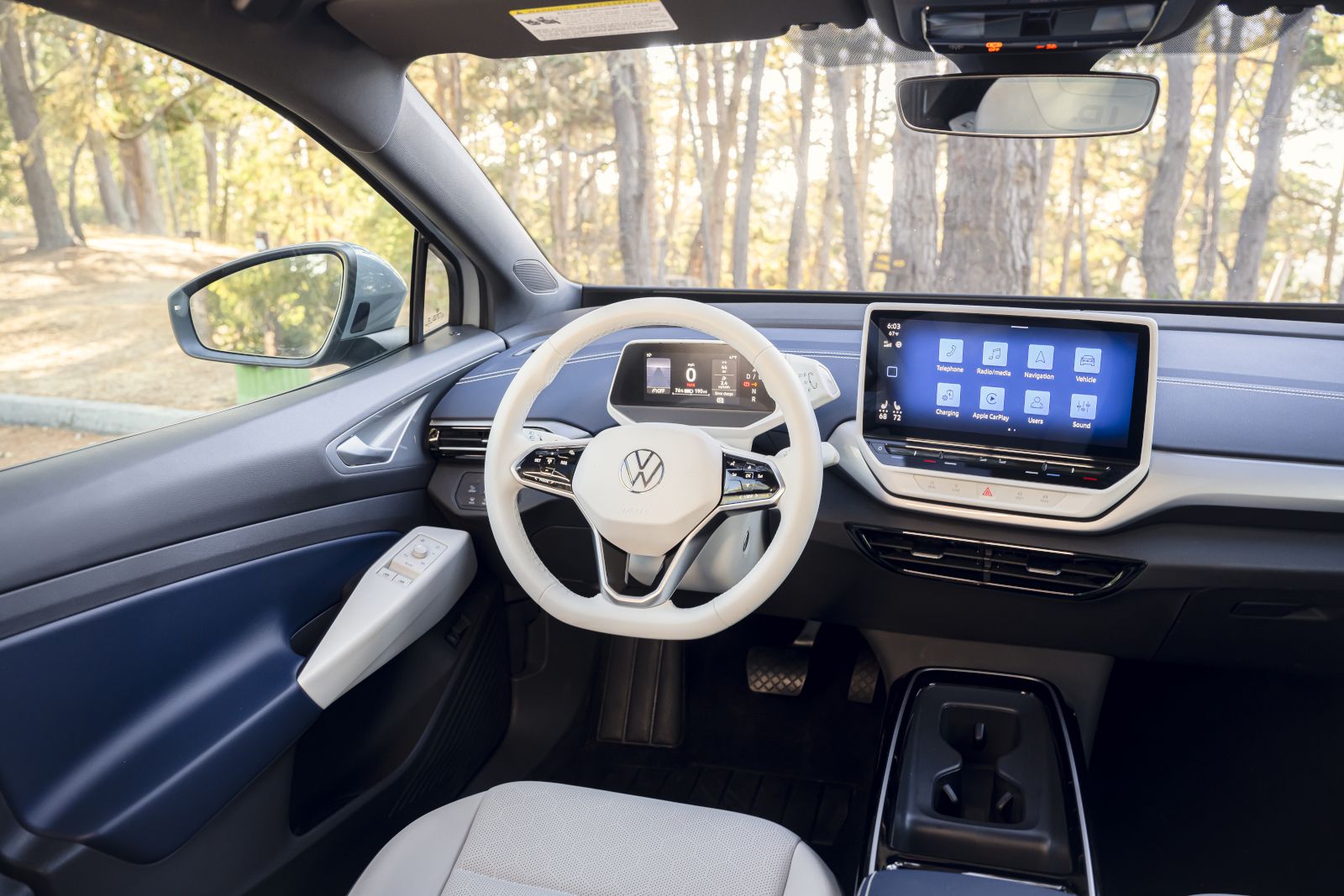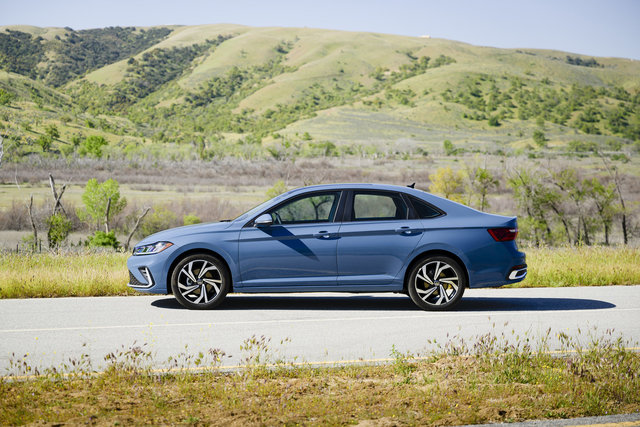Highway driving across Ontario presents specific challenges that differ from city streets. Higher speeds, heavy transport traffic on Highway 401, and long stretches of monotonous road can test driver attention and reaction times. Volkswagen's IQ.DRIVE technology includes several features designed to assist drivers during these conditions, reducing fatigue and helping prevent common highway incidents.
These systems come standard on most 2026 Volkswagen models, using a combination of radar sensors, cameras, and software to monitor the road environment. Understanding how each feature works helps you use them effectively during your daily commute or longer trips across the province.
How Travel Assist Maintains Speed and Lane Position
Travel Assist combines two separate functions into one integrated system. The adaptive cruise control portion maintains your set speed while adjusting to match slower vehicles ahead of you. The lane-keeping component monitors road markings and provides gentle steering inputs to help centre your vehicle within its lane.
When activated, Travel Assist handles acceleration, braking, and minor steering adjustments during highway driving. You keep your hands on the wheel and remain in control, but the system reduces the constant small corrections needed to maintain speed and position. This proves particularly useful during long stretches on Highway 7 or Highway 6 around Guelph, where traffic patterns remain relatively consistent.
The system works by detecting the vehicle ahead and measuring the closing distance. If traffic slows, Travel Assist reduces your speed automatically. When the road clears, it accelerates back to your preset speed. The steering assistance activates only when clear lane markings are visible—worn or snow-covered lines may limit this function.
Side Assist Monitors Your Blind Spots
Side Assist uses radar sensors mounted at the rear of the vehicle to detect other vehicles in adjacent lanes. When a vehicle enters your blind spot—the area beside and slightly behind your car where mirrors don't provide full visibility—a warning light appears in the corresponding side mirror. If you activate your turn signal while a vehicle occupies that space, the warning intensifies.
This feature addresses one of the most common causes of highway lane-change collisions. On multi-lane highways like Highway 401, vehicles approach at different speeds and angles that make them difficult to track visually. Side Assist provides continuous monitoring that doesn't depend on checking mirrors at precisely the right moment.
The system distinguishes between vehicles that pose a collision risk and those that are simply in adjacent lanes but not in dangerous positions. Stationary objects don't trigger warnings, nor do vehicles more than one lane away from your position.
Front Assist Detects Potential Collisions
Front Assist monitors the road ahead for vehicles, pedestrians, and cyclists. The system calculates the closing rate between your vehicle and objects in your path. If it determines a collision is likely, it provides visual and audible warnings to alert you. In situations where you don't respond quickly enough, Front Assist can automatically apply the brakes to reduce impact severity or avoid the collision entirely.
The automatic emergency braking function activates only in specific circumstances where a collision appears imminent and the driver hasn't taken corrective action. This serves as a last-resort safety measure rather than a primary driving aid. The system can detect pedestrians traveling parallel to the vehicle and alert you to their presence—useful when navigating parking lots or urban areas near highway exits.
Front Assist relies on clear sensor visibility. Heavy rain, snow, or dirt covering the front radar and camera can reduce system effectiveness. Regular cleaning of these components maintains optimal performance.
Emergency Assist Responds to Driver Incapacitation

Emergency Assist monitors driver inputs through the steering wheel. If the system detects no steering input for an extended period—suggesting the driver may be experiencing a medical emergency—it initiates a series of warnings. These include visual displays, audible alerts, and gentle brake applications to get the driver's attention.
If the driver still doesn't respond, Emergency Assist brings the vehicle to a controlled stop in its current lane while activating hazard lights. This prevents the vehicle from continuing uncontrolled at highway speeds if the driver becomes suddenly unable to operate it.
The system requires either Lane Assist or Travel Assist to be active before it can intervene. Emergency Assist constantly evaluates whether normal driving behaviour is occurring based on steering wheel movements and other inputs.
How These Systems Work Together on Highway 401
The IQ.DRIVE features function independently but are designed to complement each other during typical highway driving situations. Consider a scenario on Highway 401 between Guelph and Mississauga:
Travel Assist maintains your speed and lane position in moderate traffic. Side Assist monitors vehicles in adjacent lanes as traffic patterns shift. Front Assist tracks the distance to vehicles ahead, ready to alert you if traffic suddenly slows. Emergency Assist runs in the background, ensuring the vehicle responds appropriately if you become incapacitated.
Each system has specific triggers and limitations. Travel Assist requires visible lane markings. Side Assist focuses on vehicles entering blind spots rather than all surrounding traffic. Front Assist prioritizes imminent collision threats. Emergency Assist activates only when other systems detect potential driver incapacitation.
Key Takeaways
|
Feature
|
Primary Function
|
When It Activates
|
|
Travel Assist
|
Maintains speed and lane position
|
When engaged on highways with clear lane markings
|
|
Side Assist
|
Monitors blind spots
|
When vehicles enter adjacent lanes beside or behind you
|
|
Front Assist
|
Detects potential collisions
|
When closing rate suggests possible impact with vehicle, pedestrian, or cyclist
|
|
Emergency Assist
|
Responds to driver incapacitation
|
When no steering input detected for extended period with Lane Assist or Travel Assist active
|
Understanding System Limitations
While IQ.DRIVE features provide valuable assistance, they don't replace attentive driving. Weather conditions affect sensor performance—heavy snow, fog, or rain can reduce system effectiveness. Road conditions matter too—construction zones with unclear lane markings may limit Travel Assist functionality.
The systems are designed to assist rather than take over driving responsibilities. Travel Assist requires you to keep your hands on the wheel. Front Assist provides warnings and emergency braking but expects you to remain alert to road conditions. Side Assist supplements mirror checks rather than replacing them.
Regular maintenance keeps these systems functioning properly. Sensor cleaning, software updates, and proper calibration after windshield replacement all contribute to reliable performance.
Learn More at Guelph Volkswagen
IQ.DRIVE technology appears as standard equipment on most 2026 Volkswagen models, providing driver assistance features that address common highway driving challenges. Visit our team in Guelph to experience how these systems function during a test drive on local highways and roads.









